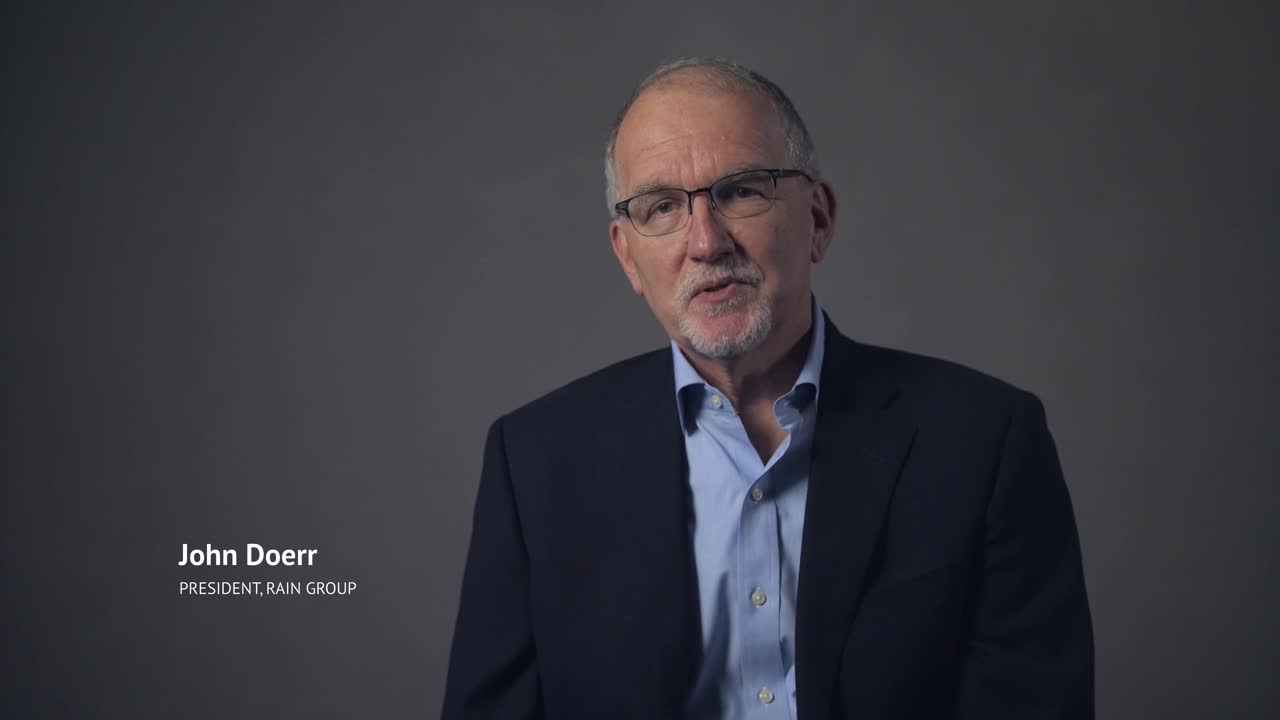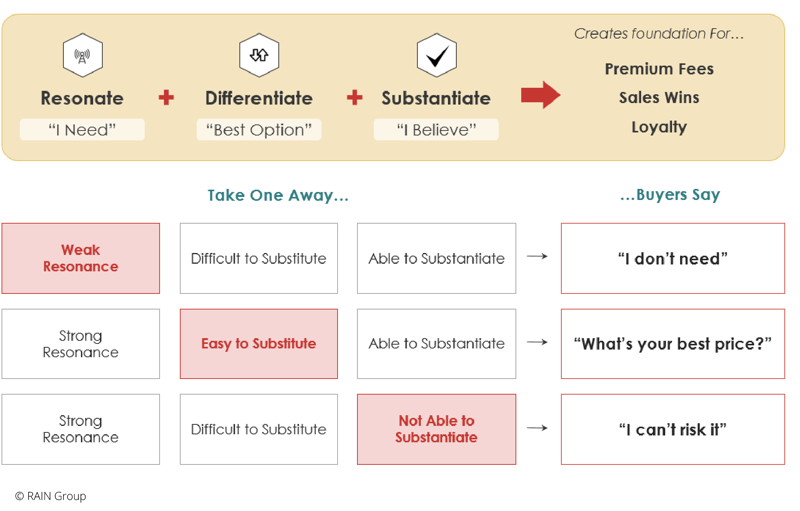Ask 100 sellers at 100 companies why their customers buy from them, and you’re likely to hear 100 answers with the same underlying theme: the value we provide.
Sellers describe their value to us in several ways: we get results. Our relationships are very close. They get from us what they’ve always wanted (but never gotten) from other companies. We bring innovative solutions to the table. And so on.
Pretty obvious, right? To win sales you must maximize value.
In practice, there’s no denying that sales winners are much better at getting buyers to perceive maximum value than the rest. In fact, in our research, only one factor—"overall value was superior”—was of top importance to buyers in all of the categories we studied (e.g., how winners win the initial sale, what drives repeat business, what drives referrals, etc.).
Before you can learn how to communicate value, you need to understand some key concepts about it.
What is a Value Proposition?
- Value: The monetary worth of something; that is, whether and how much someone will pay for something.
- Value Proposition: The collection of reasons why a buyer buys; in essence, factors that affect whether they purchase, and from whom.
- Value Proposition Positioning Statement: A compelling, tangible statement of how a company or individual will benefit from buying something specific or buying from you in general.
Most people, however, only think of the third bullet. For example:
What Does Value Proposition Mean?
A business or marketing statement that summarizes why a consumer should buy a product or use a service. This statement should convince a potential consumer that one particular product or service will add more value or better solve a problem than other similar offerings.
Investopedia Explains Value Proposition
Companies use this statement to target customers who will benefit most from using the company’s products, and this helps maintain an economic moat. The ideal value proposition is concise and appeals to the customer’s strongest decision-making drivers. Companies pay a high price when customers lose sight of the company’s value proposition.
You'll note that in the Investopedia definition and explanation they reference a value proposition only as statement with the common elements of what people refer to as an elevator pitch.
Not many purchases are made in elevators, and people don’t buy because of two key points in a brief statement. They buy for their own reasons, often different from one buyer to the next.
Don’t get me wrong. It’s helpful to be able to pick key points that often resonate with buyers, and have them at the ready for discussions when you meet people for the first time. We call this a value proposition positioning statement. If you only do this, though, you’ll limit your possibilities for building the maximum case for your value with clients during the selling process.
Value Proposition Definition
The collection of reasons why a buyer buys; in essence, factors that affect whether they purchase, and from whom.
If you think of a value proposition not as a statement, but as a concept about why people buy something, then you’ve got a lot more to work with. It’s from that concept—the collection of reasons why people would want to buy from you—that you can put your selling efforts to work much more effectively, communicating different components of that value in different ways for different situations.
The collection of reasons why people buy typically fall into three major buckets that form the three rules of winning value propositions:
- Buyers have to want and need what you’re selling. You have to resonate.
- Buyers have to see why you stand out from the other available options. You have to differentiate.
- Buyers have to believe that you can deliver on your promises. You have to substantiate.
The 3 Legs of the Value Proposition Stool
What happens if you don't follow all three of the value proposition rules?
As you can see from the graphic above, take any one of these away and it makes it much more difficult to sell.
- Remove resonance and people just won’t buy what you’re selling or won't buy it from you, because what you bring to the table isn't important enough. They also won’t be willing to move forward with any amount of urgency.
- Remove differentiation and there’s no clear indication that you’re the best choice. The buyer will pressure your price or attempt to get it someplace else.
- Remove your ability to substantiate your claims and buyers won’t risk working with you. They won’t believe you’ll be able to fulfill your promises or achieve intended results.
Again, statements that encapsulate the mission and value of a firm are helpful early in discussions. Many buyers are skeptical at this stage, especially if you and your organization are an unknown quantity. It takes time to resonate, differentiate, and substantiate, but it’s worth doing.
By summing up your organization in this way, you help buyers understand where and when you can help them. However, there’s always a set of underlying factors and specifics that sway any particular buyer to choose you instead of building an in-house solution, finding someone else to help them, or deciding to do nothing at all.
This is where a strong value proposition helps. You need to convince the buyer of the impact of your solution, and what will happen if they move forward with you compared to these other options. To take this a step further, a sales impact model can help you demonstrate financial benefits of working with you and map out the context of your offer.
To fulfill these three rules, you need your buyers to be able to answer four important questions.
4 Questions to Build a Value Proposition
Imagine it's the end of a long, important sales process. Your buyer has given you the verbal 'yes' to buy, but they have to deliver a summary of the value proposition case—why they’ve made the decision to move forward with you—to their peers and the board of directors. And no, you can't attend the meeting and present your case. They’re on their own to make the argument, and it has to be good.
Just as you’ve had to resonate, differentiate, and substantiate yourself and your solution to get this far, so too does your buyer. If you can succeed, you’ll have someone in the buyer’s organization willing to champion you, even when you’re not in the room.
If you want buyers to be armed with the best material to make this case, first you must be able to make it to yourself.
The most successful sellers make the value case to themselves as powerfully as possible—before getting buyers to believe in it just as strongly. Making the value proposition case is straightforward if you ask the following questions.
4 Essential Value Proposition Questions
- Why act?
- Why now?
- Why us?
- Why trust?
Why act and why now cover resonance. Here you make the case for why it's important and urgent to move forward.
Why us covers differentiation. Here you make the case for why you are the best choice among available options.
Why trust covers substantiation. It's where you make the case for why the buyer should believe in you, your offering, your company, and your ability to achieve the desired and promised results.
In this video, we share more about these 4 questions and why it's important to customize your value proposition for each buyer.

Mapping Out Your Value
If you answer these 4 questions, covering each of the essential components, you win sales at premium fees and inspire buyer loyalty.
If you want to resonate, differentiate, and substantiate you need to do much more than write a short pitch. While you can sum it up, the summary itself isn't enough to drive the buying decision. It just does a little positioning for you.
Your actual value proposition—the collection of reasons people buy from you—will be different from one buyer to the next. You’ll discover what it should be for each buyer through your conversations as you learn what they want and need, and who the competition is.
Then and only then will you be able to craft the most compelling solution and messaging for them.
If you do, the buyer’s perception of your value will be as strong as possible when it counts: when it’s time to buy.








